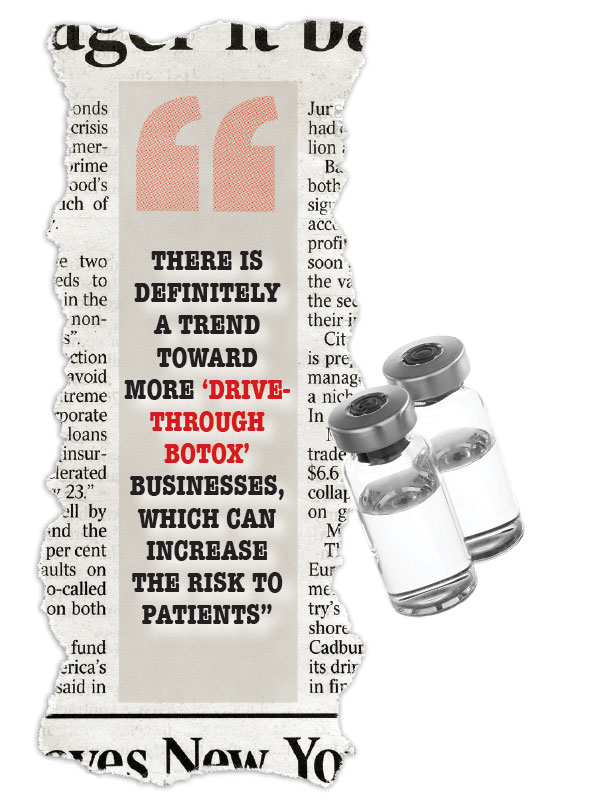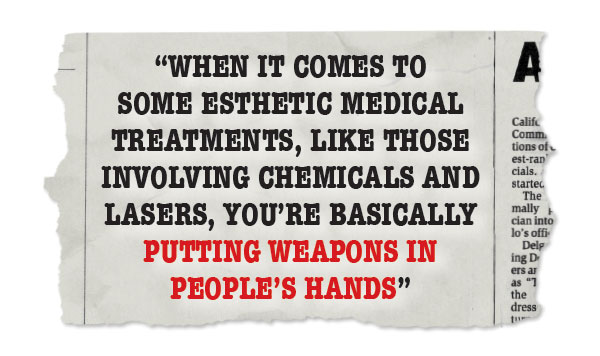Botched: What Happens When There’s No “Med” in “Med Spa”?

Patients with botched cosmetic treatments were attributed to medical spas. Photo: Yulia Reznikov/Getty Images
Several years ago, a 50-year-old woman walked into Dr. Renita Ahluwalia’s clinic in Toronto, desperate for help. Her cheeks were badly scarred and the cartilage in her nose was destroyed, making it look as though it had caved in at the bridge. It was one of the worst cases of a cosmetic procedure gone wrong that Ahluwalia had seen in 10 years practising dermatology.
“I don’t know what was injected into her skin, but I believe that it caused a rare inflammatory condition that leads to ulceration,” she says. “I’m doing my best to treat it, but it has caused severe, permanent damage to my patient’s face.”
That patient is Fernanda, who didn’t want to use her last name for privacy reasons. About five years ago, Fernanda saw a sign in the window of a self-described medical spa in Toronto, advertising a Botox special. “That’s what drew me in,” she says. “The price was amazing.” She arrived, filled out some paperwork (Did she have allergies? Any pre-existing health conditions?), signed a waiver – and that was it. “The woman treating me said, ‘Let’s put some filler in your nose and cheeks, and some in your lips.’” Fernanda had a bump in her nose that had always bothered her and she was told the filler would make it less noticeable. She agreed.
Two days later, cyst-like lumps, in this case known as granulomas, formed on her lips. Although they eventually disappeared on their own, they were followed by another granuloma on her right cheek, which she had to have surgically removed. Then, a cluster of granulomas began appearing on her left cheek. Although Fernanda had recently embarked on a new career in palliative care, she had to stop working. “I couldn’t go out looking like this.”
Because the bumps on her face didn’t manifest until more than a year after her injections, Fernanda was diagnosed with everything from a bacterial infection to lupus, and underwent several years of treatment for a variety of conditions before she wound up in Ahluwalia’s office. Even then, it took a team of dermatologists almost nine months to make the connection and arrive at a diagnosis. But when Fernanda called the spa where she’d had the treatment, she was told her disfigurement couldn’t possibly be because of the fillers. And, besides, she had signed a waiver. “I have pictures,” Fernanda says. “If I were to show you what happened to my face, it’s devastating. I promised myself I wouldn’t cry talking about it … but it changed the trajectory of my entire life.”
There’s no way of knowing what caused Fernanda’s inflammation – whether it was an inexperienced injector, an unlicensed, counterfeit product or a reaction to the product itself – but it’s a cautionary tale, given Fernanda was attracted by a discount, talked into fillers, doesn’t know exactly what she was injected with and, when she contacted the spa, there was no accountability.

In a survey of American Society of Dermatologic Surgery members, published in 2020, researchers discovered 70 per cent of 306 dermatologists reported seeing at least one patient – and as many as 20 – with botched cosmetic treatments in the past two years, the majority of which were attributed to medical spas. There is no recent data from Canada, although a survey of Canadian dermatologists in 2012 raised concerns about burns caused by laser hair removal. The most common issues U.S. dermatologists reported included discolouration and burns from intense pulsed light treatments and laser hair removal, as well as reactions and infections arising from misplaced fillers.
Ten years ago, Toronto dermatologist Dr. Lisa Kellett might have encountered post-esthetic spa complications every few months – now she sees them every week. “Don’t even get me started,” Kellett says. “These places are the bane of my existence.” The worst cases she’s seen have been vascular occlusions, where filler was injected into, or too close to, an artery, blocking blood flow and causing the surrounding skin to die. In rare cases, it can lead to blindness. “If you can diagnose it, you can treat it,” Kellett says. “But in these situations, even if the injector had diagnosed it correctly, they didn’t know what the treatment was.”
The problem, Kellett says, is that pretty much anyone can open a clinic that offers esthetic medicine and call it a med spa. “It’s difficult to have someone go in and regulate med spas, because they’re popping up on every corner,” she says. Esthetic medicine was an already lucrative industry that flourished during the pandemic, thanks to all the hours people spent contemplating their fine lines and tired eyes on Zoom calls. In 2020, the global med spa industry was valued at more than US$12 billion (the equivalent of almost C$16 billion) – a figure that’s expected to reach nearly US$26 billion (C$34 billion) by 2026, according to the Dublin-based data firm Research and Markets.

The fact most esthetic spas work “med” or “medi” into their clinic names is interesting, Ahluwalia says, considering there is often nothing remotely medical about them. “Lasers and injectables are medical procedures and should be treated as medical procedures,” she says. “Technically, these clinics should have a medical director who is a physician or, at the very least, a nurse practitioner, and they should be on site; but that’s not what happens a lot of the time.” In some cases, she says, there may be a medical director who signs off on order forms for fillers and neurotoxins, but isn’t actually overseeing treatments or ensuring staff are properly trained. “They could also be getting product from anywhere, and a lot of the time we don’t even know what was injected into a patient.” Inexperienced estheticians wielding devices like lasers are equally terrifying, Ahluwalia says. “Anyone can buy a laser, and a serious laser at that, and there’s no requirement for training whatsoever.”
Both Kellett and Ahluwalia are frustrated by the lack of rules around spas that offer esthetic medicine. Provincial colleges regulate physicians and nurses, “but often the people doing these treatments aren’t doctors or nurses and they have no one to report to,” Ahluwalia says. To become a dermatologist requires four years of undergrad, followed by four years of medical school, then five years of dermatology and often a fellowship after that. Should you wish to skip 13-plus years of education, a quick Google search reveals that all you need is a high-school diploma to enroll in any number of esthetic schools offering crash courses in everything from chemical peels to laser hair removal.
About 10 years ago, when she was in her mid-30s, Karen Macdonald ventured into one of these esthetic schools for a laser skin tightening treatment. Like Fernanda, she had been attracted by a sign in the window offering a sale. During the procedure, she found herself alone with the esthetician-in-training and immediately felt something was wrong. “I’d never done anything like this before and wasn’t sure if it was “normal” pain, but it was intense.” The laser burned Macdonald’s skin along her smile line and left a cut. “I could tell the woman was shocked and didn’t know what to do. She ran to get her trainer, who suggested that I come back and try a different treatment next time. I still have a scar.”
Macdonald currently works as a manager in Kellett’s dermatology clinic. “Now that I work in the industry, I’ve seen how much additional training goes into making sure these treatments are done properly,” she says. “But back then, I had no idea. It’s quite scary.” She recalls a recent conversation with a friend who took a crash course in medical esthetics and is now working in a clinic, where she is expected to do laser hair removal, despite having practised it once before in class. “One of her first clients was a man who came in for a Brazilian,” Macdonald says, “a pretty sensitive area, if you make a mistake.”
In 2016, the Quebec College of Physicians and Surgeons published a report outlining 14 recommendations for the regulation of esthetic medicine, including that estheticians without medical backgrounds should no longer be allowed to operate lasers. Four years later, the college published a practice guide with stricter rules around training, but the rules only apply to those practising esthetic medicine in Quebec. With no federal standards or formal licensing body to provide certification for cosmetic services, the onus falls on patients to do their research, says Dr. Katie Beleznay, a clinical instructor with the department of dermatology at the University of British Columbia. “There is definitely a trend toward more ‘drive-through Botox’ businesses, which can increase the risk to patients,” she says.
Beleznay recommends researching providers who have both a medical education and specialized training, and who are working in the industry full time, not as a side hustle. The treatment provider should ask for your complete medical history, discuss your goals, present you with a personalized treatment plan and review all the risks and benefits. “Don’t be afraid to ask questions,” she says. “And confirm the person you’re speaking with will be the one performing the treatment.”

If your gut tells you it’s not a reputable clinic, then follow your gut, Kellett adds. One way to know for sure is to find a doctor through Aesthetic Medicine Network Inc. (AMNI), a national association of cosmetic doctors who are members of either the Royal College of Physicians and Surgeons of Canada or the College of Family Physicians of Canada. But, until a federal governing body steps in and decides the cosmetic medicine industry needs tighter guidelines from coast to coast, Canadian dermatologists will continue repairing the damage as best they can, Kellett says. She treats reactions to fillers by dissolving the filler in question or by prescribing steroids or antibiotics. Some complications, like scarring and pigment change, can be reduced with laser and light treatments, but the damage isn’t always reversible. “I feel badly for patients and I try my best to help, but it’s awful for them,” she says.
Kathryn Gallagher, the chair of Leading Spas of Canada – the only national association for the spa industry – sees why dermatologists have an issue with spas, but says it will take openness and collaboration to solve the problem. The first step toward greater accountability is for the government to distinguish between spas and other personal-care services. “Right now, there is no way of even knowing how many spas there are in the country – let alone how many offer medical esthetic services – because we’re lumped in with tattoo parlours, hair salons and nail bars,” says Gallagher, a professor in the Esthetician, Esthetics and Medical Spa Therapies program at Seneca College in Toronto. “It’s like the Wild West out there.”
In 2009, Leading Spas of Canada established a Quality Assurance certification program, where health inspectors assess participating spas, based on everything from standard operating procedures to staff qualifications. Gallagher worries about the proliferation of spas offering esthetic medical services, and until the government steps in to create official standards, she says the association will continue to do it themselves for spas that want that credibility. She only wishes it wasn’t optional. “When it comes to some esthetic medical treatments, like those involving chemicals and lasers, you’re basically putting weapons in people’s hands,” she says. “And it’s only a matter of time before someone gets really hurt.”
Fernanda has lost count of the number of times she has cried in Ahluwalia’s office. Her ordeal is far from over. A plastic surgeon recently repaired a hole on her nose and next will attempt to surgically flatten the raised scars on her cheeks. “With all the scarring, my face feels numb and it’s hard to move,” she says. “It doesn’t even feel like me anymore.” For a long time, Fernanda blamed herself, and hopes that sharing her experience will prompt other people to look at cosmetic medicine differently. “It’s all so mainstream now, that we tend to think of it as the same as just going in and getting our eyebrows waxed,” she says. “But it’s not the same thing at all and, if something goes wrong, it can be devastating.”
A version this article appeared in the August/September 2022 issue with the headline ‘Botched’, p. 64.
RELATED: